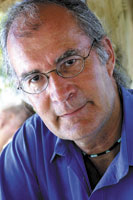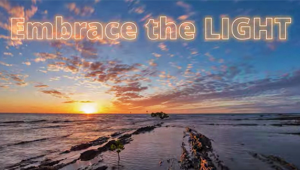The Fine Art Of Photography
As someone who has paid the rent with photography since high school I often
find myself uncomfortable when the words "photography" and "art"
are linked in a sentence, especially when art is spelled with a capital "A."
I see photography as a craft, one that takes rigor, training, and sacrifice
to get right. But I also see photography as an art; indeed, it is the blend
of art and science, of technique and vision, that is unique among all the visual
arts and what makes photography such a fascinating field of work and play. Lately,
many of us have had to deal with lots of change on the science end of the deal.
Digital imaging is a demanding taskmaster, and at times the changes come so
fast that we get hung up on them to the detriment of what got us involved in
making images in the first place. But in the end all the science should be the
servant of the photographer's vision, and not the other way around.
 The debate on what makes something art or not art goes back as far as Aristotle,
and probably even further back when the first cave painting I am sure had its
share of critics. ("You call that a bison?") The debate about photography
and art got started a few minutes after the first emulsion dried, some 168 years
ago. The source of objections, not surprisingly, was mainly painters and others
engaged in two-dimensional media, many of whom felt threatened by the supposed
ease with which a photographer could "draw from nature." Many were
members of academies who fought to ban photographs from salons and galleries,
an attitude that though less apparent today still exists in some quarters. Indeed,
an offshoot of the argument today is about what constitutes real photography--silver
halide or digital imaging. Some folks feel that somehow digital imaging is simply
not photography, or that there is something inherently purer about film as the
recording medium.
The debate on what makes something art or not art goes back as far as Aristotle,
and probably even further back when the first cave painting I am sure had its
share of critics. ("You call that a bison?") The debate about photography
and art got started a few minutes after the first emulsion dried, some 168 years
ago. The source of objections, not surprisingly, was mainly painters and others
engaged in two-dimensional media, many of whom felt threatened by the supposed
ease with which a photographer could "draw from nature." Many were
members of academies who fought to ban photographs from salons and galleries,
an attitude that though less apparent today still exists in some quarters. Indeed,
an offshoot of the argument today is about what constitutes real photography--silver
halide or digital imaging. Some folks feel that somehow digital imaging is simply
not photography, or that there is something inherently purer about film as the
recording medium.
Photography, whether film or digital, is an art form at its core in that the end result is an image. That image can mirror "reality," create abstractions of color and light, reveal all or obscure parts of the scene, or even fool the eye. Photographers, through their choice of lens, can show a world unseen by the unaided eye. They can, and this is key to what to me makes for art, interpret the world when they snap the shutter, and reinterpret it when the image is processed and printed later. It is running reality through a personal filter and then projecting the image back out at the world that makes for an artistic statement. The image has the power to evoke emotions, from sentimentality to anger, and even change attitudes about the world. Photographers can prove and reinforce ideas through images, or show us that the emperor has no clothes. And, when done in masterful fashion, photographs can inspire in others a desire to become engaged in this personal quest, to pick up a camera and contribute their own vision to the world.
If that doesn't define art then I am uncertain what art might be.
In this issue we come at the topic in a number of ways, as is our wont. We include musings on fine art and experiences of streetwise pros, as well as profile both web and print photographers who have answered the call of their own internal muse. But we also recognize that in some way every picture made has an element of art to it, if only in the fact that a human being with a tool decides that one moment in the rush of energy and events deserves that most amazing thing--an image.
In closing, I'd like to thank you and all our readers for your support this year. The work that all the staff does on Shutterbug and shutterbug.com is dedicated to making the magazine and website interesting, educational, and inspirational for you. We hope you have enjoyed them as much as we enjoyed bringing them to you. We have grown over the last year and look forward to another exciting year to come. So thanks again, and please accept our best wishes for you and yours in 2008.

 The debate on what makes something art or not art goes back as far as Aristotle,
and probably even further back when the first cave painting I am sure had its
share of critics. ("You call that a bison?") The debate about photography
and art got started a few minutes after the first emulsion dried, some 168 years
ago. The source of objections, not surprisingly, was mainly painters and others
engaged in two-dimensional media, many of whom felt threatened by the supposed
ease with which a photographer could "draw from nature." Many were
members of academies who fought to ban photographs from salons and galleries,
an attitude that though less apparent today still exists in some quarters. Indeed,
an offshoot of the argument today is about what constitutes real photography--silver
halide or digital imaging. Some folks feel that somehow digital imaging is simply
not photography, or that there is something inherently purer about film as the
recording medium.
The debate on what makes something art or not art goes back as far as Aristotle,
and probably even further back when the first cave painting I am sure had its
share of critics. ("You call that a bison?") The debate about photography
and art got started a few minutes after the first emulsion dried, some 168 years
ago. The source of objections, not surprisingly, was mainly painters and others
engaged in two-dimensional media, many of whom felt threatened by the supposed
ease with which a photographer could "draw from nature." Many were
members of academies who fought to ban photographs from salons and galleries,
an attitude that though less apparent today still exists in some quarters. Indeed,
an offshoot of the argument today is about what constitutes real photography--silver
halide or digital imaging. Some folks feel that somehow digital imaging is simply
not photography, or that there is something inherently purer about film as the
recording medium. Photography, whether film or digital, is an art form at its core in that the end result is an image. That image can mirror "reality," create abstractions of color and light, reveal all or obscure parts of the scene, or even fool the eye. Photographers, through their choice of lens, can show a world unseen by the unaided eye. They can, and this is key to what to me makes for art, interpret the world when they snap the shutter, and reinterpret it when the image is processed and printed later. It is running reality through a personal filter and then projecting the image back out at the world that makes for an artistic statement. The image has the power to evoke emotions, from sentimentality to anger, and even change attitudes about the world. Photographers can prove and reinforce ideas through images, or show us that the emperor has no clothes. And, when done in masterful fashion, photographs can inspire in others a desire to become engaged in this personal quest, to pick up a camera and contribute their own vision to the world.
If that doesn't define art then I am uncertain what art might be.
In this issue we come at the topic in a number of ways, as is our wont. We include musings on fine art and experiences of streetwise pros, as well as profile both web and print photographers who have answered the call of their own internal muse. But we also recognize that in some way every picture made has an element of art to it, if only in the fact that a human being with a tool decides that one moment in the rush of energy and events deserves that most amazing thing--an image.
In closing, I'd like to thank you and all our readers for your support this year. The work that all the staff does on Shutterbug and shutterbug.com is dedicated to making the magazine and website interesting, educational, and inspirational for you. We hope you have enjoyed them as much as we enjoyed bringing them to you. We have grown over the last year and look forward to another exciting year to come. So thanks again, and please accept our best wishes for you and yours in 2008.


































